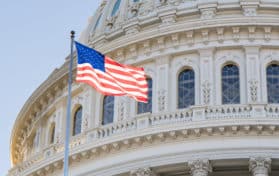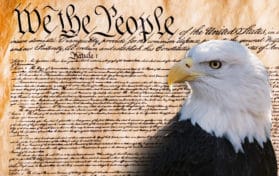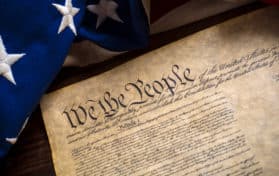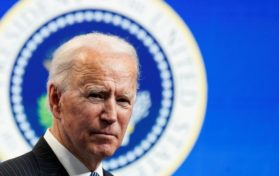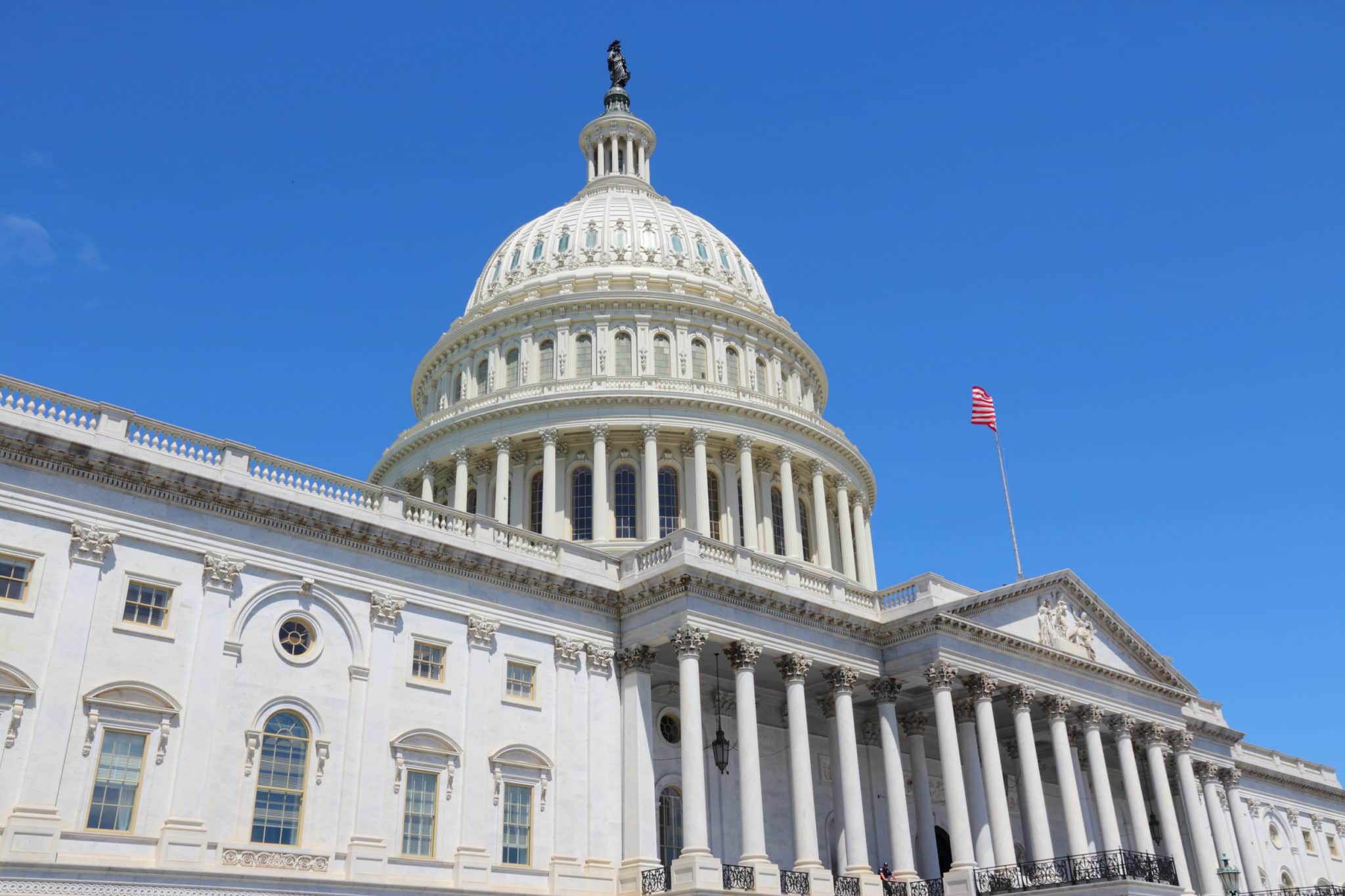
Simply winning the American Revolution did not automatically make America a new country; in fact, much debate surrounded setting up a new government in the burgeoning country. The Founding Fathers struggled to establish a government that guaranteed individual rights as well as set forth the responsibilities of the central government.
When studying Congress facts, we learn the entity was not established immediately after the end of the American Revolution. The First Congress took place between 1789 and 1791; however, this isn’t the same Congress we recognize today. Congress is meant today to be a representative of the citizens of the United States. It is a strong part of the system of checks and balances in American government.
U.S. Congress Facts
Facts About the Establishment of Congress
1. The current Congress was established on March 4, 1789. The first Congress met in New York City, but would relocate to Congress Hall in Philadelphia, PA. This relocation took place in 1790.
2. The First Congress was made up of sixty-five representatives. The First Congress lasted for two years; they met from March 4, 1789 to March 4, 1791.
3. The First Congress was tasked with “finishing what the Founders started.” Over the course of two years, the First Congress would pass the first twelve amendments to the Constitution. However, this was just one of the pieces of business taken care of during the course of the First Congress.
4. The First Congress was made up of sixty-five representatives.
5. The president of the Senate of the First Congress was none other than John Adams. The President Pro Tempore was John Langdon.
6. Once the first twelve amendments to the Constitution were passed by the First Congress, they were sent to the states for ratification. Ten of them were approved for ratification, and this is what led to the Bill of Rights, ratified on December 15, 1791.
7. The Speaker of the House for the First Congress was Frederick Muhlenberg.
8. There were three sessions of the First Congress. The first session was from March 4, 1789 – September 29, 1789. The second session took place from January 4, 1790 to August 12, 1790. The final session ran between December 6, 1790 and March 3, 1791.
9. During the First Congress, two states joined the United States. North Carolina ratified the Constitution on November 21, 1789. Rhode Island followed suit on May 29, 1790.
10. During the First Congress, there were no political parties represented as we recognize them now. An analysis of a member’s voting record caused individuals to be grouped together based on voting habits.
Important Events of the First Congress
11. On April 6, 1789, the House of Representatives and the Senate met together to count the Electoral College ballots and certify them. This action made George Washington the first president and John Adams the Vice President. Washington was unanimously elected.
12. The First Congress set up a system of revenue for the nation, which included assigning a monetary “duty” to “tonnage” – in other words, they set up a system of imports and exports and set up a customs tax for products brought into the country.
13. Three Executive Departments were set up by the First Congress. The Department of Foreign Affairs was one of these departments; it was soon renamed “the State” (as in the Secretary of State who serves in diplomatic affairs). The First Congress also set up the Department of Treasury as well as the Department of War.
14. The First Congress made a provision for a Postmaster General as well as an Attorney General for the United States.
15. The first Congress established the Judiciary branch of the federal government. This was known as the Judiciary Act.
16. James Madison, the author of the Bill of Rights, was a member of the House of Representatives to the First Congress.
17. The Compromise of 1790, one of the acts of the First Congress, cited Washington, DC as the nation’s capital city.
18. Besides James Madison, other notable individuals involved in the First Congress included James Monroe, Roger Sherman, Oliver Ellsworth, Fisher Ames, and Rufus King.
19. The Oath of Office Bill was the first legislative at of the First Congress as they convened in 1789; it was signed by the Speaker of the House, Frederick Muhlenberg.
20. President George Washington signed the Permanent Seat of Government Act, which established DC as a federal city.
Facts Surrounding the Creation of Congress and its Function
21. Congress was created so that people would truly be represented by their government. It is called the Legislative Branch of the Government, but it also laid out the Executive Branch as well as the Judiciary.
22. The Legislative Branch was meant to be bicameral – made up of two houses. However, the First Congress was not made of two parties. The First Congress set up the House of Representatives and the Senate.
23. The House of Representatives and the Senate were set up to serve two different constituencies. The House was meant to be elected by the people to serve the people’s interest. The Senate at that was appointed by each state legislature; it was meant to be “one step removed from the people.” Today, both Senators and members of the House are elected by the people.
24. Article I, Section 8 of the Constitution sets the Enumerated Powers of Congress, which involves taxing, spending, borrowing and coining as well as both foreign and domestic trade; other powers given to Congress under this statute include regulation of the military, which includes the power to declare war.
25. Congress also operates under the Necessary and Proper Clause, which gives Congress the ability to make laws “deemed to be necessary to carry out the expressed powers” (of Congress).
26. The First Congress sent the first twelve amendments out to the states for ratification; however, there were those that opposed this action as they felt the Constitution itself was so new that no one could possibly know what, if anything, in the Constitution should be changed. James Madison led the argument for the legislature to pass these amendments which would later be sent to the states for the ratification process.
27. Only ten of the twelve amendments that the First Congress sent to the states to be ratified were accepted. One of those amendments was only ratified in 1992, which has come to be known as the Twenty-seventh Amendment. It was ratified only 203 years after its original proposal.
28. The twelfth amendment, which has never been ratified and is therefore NOT a part of our Constitution is an amendment that restricts the size of a congressional district to no more than 50,000 constituents.
29. The First Constitutional Amendments to the Constitution were sent to the states for ratification on September 25, 1789.
30. George Washington laid the cornerstone of the current capitol building in 1793, two years after Washington, DC was declared the permanent capital city during the First Congress meeting.
Other Interesting Facts About Congress
31. Today, there are 535 individuals making up the Congress. There are 435 Congresspeople in the House of Representatives; there are 100 in the Senate. While the number of representatives in the House may change due to population growth, every state in the Union is allowed two Senators. That number is not intended to change.
32. The House and the Senate operate under different rules for debating potential legislation.
33. Members of the House of Representatives are chosen from local Congressional Districts; the larger a state (population wise), the more representatives they are allowed. However, the members of the Senate are chosen from the state overall.
Members of the House of Representatives have a two year term, while members of the Senate are allowed a six year term.
The House of Representatives may vote to impeach a federal official, but the Senate does not have that ability. However, the Senate can vote to convict a federal official of an “impeachable offense.”
The House of Representatives is typically more partisan, but the Senate often displays less loyalty to the party.
33. The Senate has a unique debate technique called the filibuster. A filibuster can go on endlessly. The current record filibuster is held by Strom Thurmond, who spoke for just over twenty-four hours on the proposed Civil Rights Act of 1957.
34. Whatever party has the most representatives, whether in the House of Representatives or in the Senate, holds the “majority.” Leadership of both legislative houses is determined by the make up of these two houses, and it changes often, sometimes each election cycle.
The leader of the House of Representatives is the Speaker of the House, while the leader in the Senate is the Senate Majority Leader.
In the House of Representatives, there is also a House Majority and a House Minority Leader. There is also a House Majority Whip, and a House Minority Whip.
In the Senate, the Vice President plays a role in the leadership; he or she can break a tie vote if necessary. The Majority Leader is the Senate’s equivalent to the Speaker of the House.
35. Congress, as the legislative branch of the United States government, is broken into two chambers: the House of Representatives is the lower chamber while the Senate is considered the upper chamber.
Facts Regarding the 117th Congress
36. The 117th Congress began its session on January 3, 2021, and the current session will end on January 3, 2023.
37. The 117th Congress has six non-voting delegates.
38. The 117th Congress is a “50 – 50 split,” something that hasn’t occurred since the 107th Congressional session. In this case, if a vote is split down party lines, the President of the Senate (the Vice President of the United States) will step in to deliver a tie-breaking vote. The 50 – 50 split is only the third in the entire history of the Congressional body.
The 117th Congress is notable because not only does the House of Representatives have a majority of Democratic representatives, but the Executive Branch is also held by a Democratic candidate. Since the Vice-President is also a Democrat, this means that the Senate is also – albeit slightly – under the majority of the Democratic Party.
This does not mean that any and all legislation put forward by the Democratic Party can and will be approved and made into law. Because the margin of leadership in the Senate is so thin, and due to the procedures of voting a bill into law in the Senate, one or two Democratic Senators voting against a bill could effectively “kill” the bill.
39. The 117th Congress includes a Senate that includes two Independents; that means they do not belong to either the Democratic or Republican Party.
40. There are four Joint Congressional Committees. They include:
- the United States Congress Joint Committee on Taxation
- the United States Joint Economic Committee
- the United States Congress Joint Committee on the Library
- the united States Congress Joint Committee on Printing
U.S. Congress Statistics
41. Representative Jeannette Rankin of Montana was the first woman ever elected to serve in Congress. She won the post in 1916.
42. Only 395 women have ever been elected to serve as a member of Congress. Of that number, there are still 147 still serving as members of the current Congress.
43. There have been 354 women to be elected to serve in the House of Representatives.
44. Only 58 women have been elected to serve in the Senate.
45. There are seventeen women who have actually been elected to both House of Representatives and Senate posts.
46. Patsy Mink of Hawaii was elected to serve in the House of Representatives in 1964. She was the first Asian Pacific American female to be elected to serve. All total, since the establishment of the Congress, there have been a total of sixteen Asian Pacific American women elected to serve in one of the houses of Congress.
Maxie Hirono, who is currently serving in the Senate, was elected in 2012. She is also an Asian American. Ms. Hirono has served in both the House of Representatives and the Senate.
47. Fifty African American women have been elected to serve in Congress. The first, Shirley Chisholm, was from New York. She won the post in 1968. Carol Moseley Braun is the first African American woman elected to the Senate. She won this post in 1992.
48. Ileana Ros-Lehtinen, from Florida, was elected to serve as a Representative of her Congressional district in 1989. She is one of only twenty three Hispanic American women who have been elected to a Congressional post.
49. Only 162 African Americans have been elected to Congress – this statistic dates from the establishment of Congress to the body serving in the 117th Congress. This is disappointing when one considers that, over time, a total of 12,348 individuals have served as Congresspeople in both chambers.
50. Only nine African Americans have served in the Senate during that time period. One hundred fifty-two have served in the House of Representatives.
51. The Congressional Black Caucus was established in 1971 by thirteen African American members in both the House of Representatives and the Senate.
52. Hiram Revels of Mississippi was the first African American to ever serve in either the House of Representatives or the Senate. Revels served as a Senator. He was elected to the post in 1870, during the time of Reconstruction.
53. William L. Dawson was the first African American to chair a Congressional committee in 1949.
54. No native Alaskans or indigenous people have ever served as Congressional delegates.
55. Sharice Davids of Kansas and Deb Haaland of New Mexico are the first two Native American females possessing documentation of their tribal ancestry to serve in Congress. Davids was elected in 2018 as was Haaland. The 116th Congress had a grand total of four Native Americans in the membership.
56. The 117th Congress possessed the largest amount of Native Americans to ever serve at the same time, five. However, when Deb Haaland resigned her seat to become Secretary of the Interior, the number dropped to four.
57. In the Senate, three Native Americans have served:
- Charles Curtis, who was said to have Kaw, Osage, and Potawatomi tribal connections
- Robert Owen, who was a member of the Cherokee tribe
- Ben Nighthorse Campbell, a member of the Northern Cheyenne
58. The first Native American to serve in the House of Representatives was Richard H. Cain, of the Cherokee nation. His election took place in 1824.
59. As of the 117th Congress, only twenty six members of the LGBT community have held a seat in one chamber of Congress or the other.
60. Twenty five members of the LGBT community have served in the House of Representatives, while only three have held office in the Senate.
61. Two members of Congress that identify as LGBT have served in both the House of Representatives and the Senate: Tammy Baldwin of Wisconsin and Kyrsten Sinema of Arizona.
62. The first Congressperson to be identified as a member of the LGBT community is Stewart McKinney. He was elected to the House of Representatives in 1970. The first Senator to identify as LGBT is Harris Wofford. Wofford was elected in 1990. Surprisingly enough, neither of these men were outspoken regarding their time in Congress.
McKinney was identified as a bisexual only after his death. Wofford announced his plans to marry his partner twenty years after his time in the Senate ended.
63. The 117th Congress boasts the highest number of members of the LGBT community to serve in the Legislative Branch of government at the same time. There are two Senators in the 117th Congress that identify as LGBT; nine serve in the House of Representatives.
Key Takeaways
Congress was originally established in order to make laws, oversee commerce, and to perform an important part in the checks and balances system of the United States government.
The make-up of Congress has changed significantly over the 200 plus years that the body has convened. At one time, Congress was a small group of men chosen to represent the interests of their constituents. With the Civil War and Reconstruction came the inclusion of African Americans in the Legislative Branch.
However, once Reconstruction was over, African Americans were all but run out of Congressional seats. It would be another five decades or more before African Americans or women would be elected to represent voters.
Today, Congress is a body that truly represents the melting pot theory that America was founded upon. The most recent Congress includes Asian Americans, African Americans, Native Americans, and members of the LGBTQ community.
Congress still possesses the power to “check” other branches of government. The president cannot declare war without Congressional approval. Congress can enact laws, but the Judicial branch can deem them unconstitutional. At the same time, Congress can vote to increase the number of Supreme Court justices, if it so desired.
As long as our nation utilizes the system of checks and balances, Congress is a necessary entity to make sure that the people still have a say in the happenings of government.


